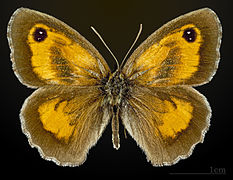Red-brown ox-eye
| Red-brown ox-eye | ||||||||||||
|---|---|---|---|---|---|---|---|---|---|---|---|---|

Red-brown ox-eye ( Pyronia tithonus ) |
||||||||||||
| Systematics | ||||||||||||
|
||||||||||||
| Scientific name | ||||||||||||
| Pyronia tithonus | ||||||||||||
| ( Linnaeus , 1767) |
The red-brown ox-eye ( Pyronia tithonus ), sometimes also called rust-brown ox-eye , brown- rimmed ox-eye or yellow ox-eye , is a butterfly from the noble butterfly family (Nymphalidae). The specific epithet is derived from Tithonus , the consort of Eos from Greek mythology .
features
butterfly
The moths reach a wingspan of 34 to 42 millimeters. Male and female moths differ significantly in their coloring, which is also known as sexual dimorphism . The males have a red-brown basic color. On the front wings, a dark scented scented spot can be seen from the inner edge . Near the wing tip there are two white centered black eye spots flowing into each other. The females have a slightly lighter basic color, which can vary from red-brown to yellow-brown to ocher. They lack the dark scented scented spot and the eye spots are slightly smaller than those of the males. Both sexes show broad brown marginal zones on the fore and hind wings. The undersides are similarly colored in male and female butterflies. While the underside of the forewings is tinted light red-brown over a large area and the eye-spots on the front shine through, the underside of the hind wings shows a slightly marbled, predominantly gray-brown color with a yellowish or whitish band in the post-disk region .
Caterpillar
The caterpillars are brownish or greenish in color. They have a dark back line, light side lines, a yellowish stripe above the feet and are slightly hairy all over the body.
Similar species
In southern Europe, North Africa and Asia Minor, the southern ox-eye ( Pyronia cecilia ) occurs, which differs from tithonus by the weaker scented scented spot in the males and an overall somewhat paler coloration in the females.
Occurrence
The red-brown ox-eye occurs from the Iberian Peninsula through Western Europe to the British Isles . In the south it can be found in central Italy, as well as in Corsica and Sardinia . Further distribution areas are the countries of the northern Balkan region to the Caucasus . The species can also be found in Morocco . The animals prefer forest edges, forest paths and clearings, but also appear on meadows and in gardens.
Way of life
The moths fly in one generation from early June to early September. For nectar intake, you will visit a variety of flowers, including field thistle ( Cirsium arvense ), late goldenrod ( Solidago gigantea ), common dost ( Origanum vulgare ), broad-leaved thyme ( Thymus pulegioides ) and buckthorn ( Rhamnus frangula ). The females either drop the eggs over grassy vegetation or attach them to stems. Forage plants of the caterpillars are various grasses, such as common red fescue ( Festuca rubra ), German ryegrass ( Lolium perenne ) or red ostrich grass ( Agrostis cappillaris ). The caterpillars can be found from September and after wintering until May. Pupation takes place in a tumbler .
Danger
The red-brown ox-eye can be found in many regions of Germany in different frequencies and is classified in category 3 (endangered) on the Red List of Endangered Species .
swell
Individual evidence
- ^ Arnold Spuler: The butterflies of Europe . tape 1 . E. Schweitzerbartsche Verlagbuchhandlung, Stuttgart 1908, p. 46 .
- ↑ Walter Forster , Theodor A. Wohlfahrt : The butterflies of Central Europe. Volume 2: Butterflies. (Rhopalocera and Hesperiidae). Franckh'sche Verlagshandlung, Stuttgart 1955, DNB 456642188 .
- ↑ a b c butterflies. 2. Special part: Satyridae, Libytheidae, Lycaenidae, Hesperiidae . In: Günter Ebert, Erwin Rennwald (eds.): The butterflies of Baden-Württemberg . 1st edition. tape 2 . Ulmer, Stuttgart (Hohenheim) 1991, ISBN 3-8001-3459-4 .
- ↑ Tom Tolman, Richard Lewington: The butterflies of Europe and Northwest Africa . Franckh-Kosmos, Stuttgart 1998, ISBN 3-440-07573-7 .
- ↑ Federal Agency for Nature Conservation (Ed.): Red List of Endangered Animals in Germany . Landwirtschaftsverlag, Münster 1998, ISBN 3-89624-110-9 .
literature
- Butterflies. 2. Special part: Satyridae, Libytheidae, Lycaenidae, Hesperiidae . In: Günter Ebert, Erwin Rennwald (eds.): The butterflies of Baden-Württemberg . 1st edition. tape 2 . Ulmer, Stuttgart (Hohenheim) 1991, ISBN 3-8001-3459-4 .
- Tom Tolman, Richard Lewington: The butterflies of Europe and Northwest Africa . Franckh-Kosmos, Stuttgart 1998, ISBN 3-440-07573-7 .
Web links
- Lepiforum e. V. Photos
- www.schmetterlinge-deutschlands.de Endangerment
- www.nic.funet.fi occurrence (English)
- Pyronia (Pyronia) tithonus at Fauna Europaea






